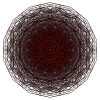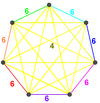Omnitruncated 6-simplex honeycomb
| Omnitruncated 6-simplex honeycomb | |
|---|---|
| (No image) | |
| Type | Uniform honeycomb |
| Family | Omnitruncated simplectic honeycomb |
| Schläfli symbol | {3[8]} |
| Coxeter–Dynkin diagrams | |
| Facets |  t0,1,2,3,4,5{3,3,3,3,3} |
| Vertex figure |  Irr. 6-simplex |
| Symmetry | ×14, [7[3[7]]] |
| Properties | vertex-transitive |
In six-dimensional Euclidean geometry, the omnitruncated 6-simplex honeycomb is a space-filling tessellation (or honeycomb). It is composed entirely of omnitruncated 6-simplex facets.
The facets of all omnitruncated simplectic honeycombs are called permutahedra and can be positioned in n+1 space with integral coordinates, permutations of the whole numbers (0,1,..,n).
A*
6 lattice[]
The A*
6 lattice (also called A7
6) is the union of seven A6 lattices, and has the vertex arrangement of the dual to the omnitruncated 6-simplex honeycomb, and therefore the Voronoi cell of this lattice is the omnitruncated 6-simplex.
![]()
![]()
![]()
![]()
![]()
![]()
![]() ∪
∪
![]()
![]()
![]()
![]()
![]()
![]()
![]() ∪
∪
![]()
![]()
![]()
![]()
![]()
![]()
![]() ∪
∪
![]()
![]()
![]()
![]()
![]()
![]()
![]() ∪
∪
![]()
![]()
![]()
![]()
![]()
![]()
![]() ∪
∪
![]()
![]()
![]()
![]()
![]()
![]()
![]() ∪
∪
![]()
![]()
![]()
![]()
![]()
![]()
![]() = dual of
= dual of ![]()
![]()
![]()
![]()
![]()
![]()
![]()
Related polytopes and honeycombs[]
This honeycomb is one of 17 unique uniform honeycombs[1] constructed by the Coxeter group, grouped by their extended symmetry of the Coxeter–Dynkin diagrams:
| A6 honeycombs | ||||
|---|---|---|---|---|
| Heptagon symmetry |
Extended symmetry |
Extended diagram |
Extended group |
Honeycombs |
| a1 | [3[7]] |
| ||
| i2 | [[3[7]]] | ×2 | ||
| r14 | [7[3[7]]] | ×14 | ||
See also[]
Regular and uniform honeycombs in 6-space:
- 6-cubic honeycomb
- 6-demicubic honeycomb
- 6-simplex honeycomb
- Truncated 6-simplex honeycomb
- 222 honeycomb
Notes[]
- ^ * Weisstein, Eric W. "Necklace". MathWorld., OEIS sequence A000029 18-1 cases, skipping one with zero marks
References[]
- Norman Johnson Uniform Polytopes, Manuscript (1991)
- Kaleidoscopes: Selected Writings of H.S.M. Coxeter, edited by F. Arthur Sherk, Peter McMullen, Anthony C. Thompson, Asia Ivic Weiss, Wiley-Interscience Publication, 1995, ISBN 978-0-471-01003-6 [1]
- (Paper 22) H.S.M. Coxeter, Regular and Semi Regular Polytopes I, [Math. Zeit. 46 (1940) 380-407, MR 2,10] (1.9 Uniform space-fillings)
- (Paper 24) H.S.M. Coxeter, Regular and Semi-Regular Polytopes III, [Math. Zeit. 200 (1988) 3-45]
| Space | Family | / / | ||||
|---|---|---|---|---|---|---|
| E2 | Uniform tiling | {3[3]} | δ3 | hδ3 | qδ3 | Hexagonal |
| E3 | Uniform convex honeycomb | {3[4]} | δ4 | hδ4 | qδ4 | |
| E4 | Uniform 4-honeycomb | {3[5]} | δ5 | hδ5 | qδ5 | 24-cell honeycomb |
| E5 | Uniform 5-honeycomb | {3[6]} | δ6 | hδ6 | qδ6 | |
| E6 | Uniform 6-honeycomb | {3[7]} | δ7 | hδ7 | qδ7 | 222 |
| E7 | Uniform 7-honeycomb | {3[8]} | δ8 | hδ8 | qδ8 | 133 • 331 |
| E8 | Uniform 8-honeycomb | {3[9]} | δ9 | hδ9 | qδ9 | 152 • 251 • 521 |
| E9 | Uniform 9-honeycomb | {3[10]} | δ10 | hδ10 | qδ10 | |
| E10 | Uniform 10-honeycomb | {3[11]} | δ11 | hδ11 | qδ11 | |
| En-1 | Uniform (n-1)-honeycomb | {3[n]} | δn | hδn | qδn | 1k2 • 2k1 • k21 |
- Honeycombs (geometry)
- 7-polytopes








